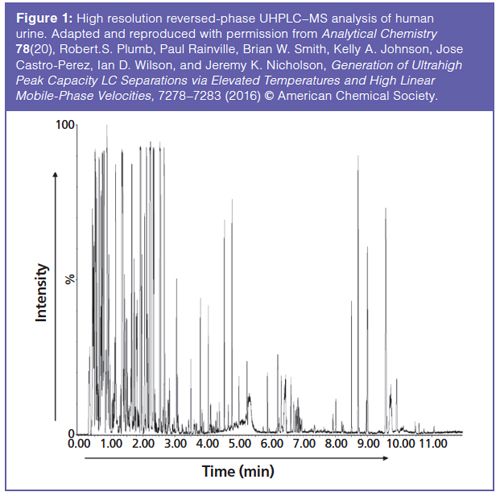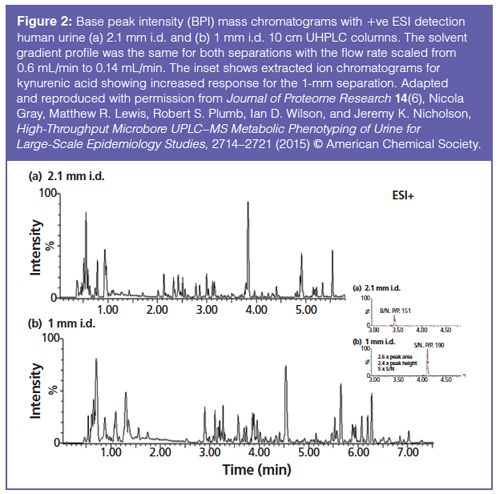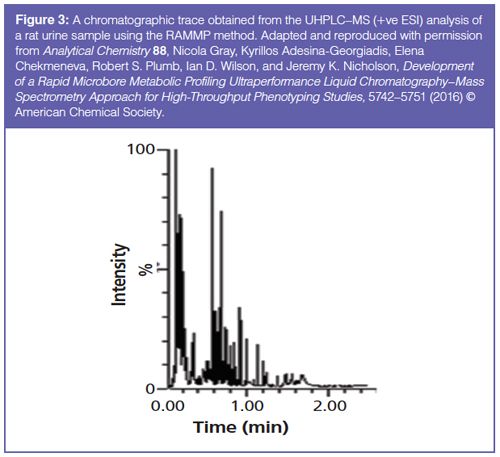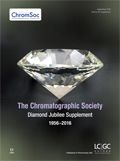Progress in LC for Complex Biological Samples — Smaller, Better, Faster
Special Issues
Ian Wilson was a principal speaker at The Chromatographic Society’s Diamond Jubilee meeting on “Advances in Microcolumn and Related Separation Technologies”, which took place in London on 22 March this year. In this article Ian and co-author Rob Plumb elaborate on the theme of the meeting.
Robert S. Plumb and Ian D. Wilson, Division of Computational and Systems Medicine, Department of Surgery and Cancer, Imperial College London, London, UK.
Ian Wilson was a principal speaker at The Chromatographic Society’s Diamond Jubilee meeting on “Advances in Microcolumn and Related Separation Technologies”, which took place in London on 22 March this year. In this article Ian and co-author Rob Plumb elaborate on the theme of the meeting.
Chromatography has always had a major role in the separation of complex mixtures and in the last halfâcentury there has been remarkable progress in the tools available to the liquid chromatographer for routine applications in separations and analysis. These are now incomparably better than those available in the 1970s when high performance liquid chromatography (HPLC) began to make serious inroads into general analytical laboratories. The early relatively primitive systems (25 cm × 4.6-mm i.d columns packed with 5–10-µm packing material, sometimes also very primitive pumps and detectors, coupled to chart recorders for data capture) were a world away from the modern instruments currently found in the laboratory. Compared to the available gas chromatography (GC) systems they were expensive (for many years the “HP” in HPLC was presumed by some to mean “high priced” rather than high performance), unreliable, and incapable of achieving the performance of GC for complex mixture analysis. However, the potential was obvious, and despite the clear problems, the major advantages that HPLC offered in terms of its ability to deal with (relatively) polar and involatile analytes made it extremely attractive to separations scientists faced with the problems of analyzing biological samples. The intervening 50 years since the introduction of HPLC has been a story of steady, if irregular, progress in both stationary phases and instrumentation. So the methods for the routine production of spherical silica particles, with a narrow size range, and reduction in particle sizes from 5 µm to 3.5 µm starting from the early to mid-1980s were major improvements, but were not achieved easily. The improved performance of these phases also resulted in a reduction in column length from 25 cm to 10 cm or 15 cm for most routine applications. For those of us working in applicationâfocused industrial laboratories, attempts at miniaturization for routine analysis for a long time consisted of reducing column internal diameters from 4.6 mm to 3.0 mm, which whilst relatively easy and, no doubt, useful did not exactly represent a paradigm shift. However, moving a pre-existing 3.0-mm i.d columnâbased assay to a 2.1-mm i.d format proved surprisingly challenging (1), in no small matter related to the dead volume and dispersion in the chromatography system and connecting tubing. However, once the difficulties associated with this further reduction in column internal diameter had been overcome, it did provide gains in reduced sample and solvent consumption together with increased sensitivity and better compatibility with mass spectrometry (MS). Further reductions in column internal diameter to 1 mm, however, did not readily yield further gains in sensitivity and this was probably a result of the difficulty in packing them efficiently.
In parallel with these modest advances in LC there were major gains in sensitivity, specificity, and the ability to identify peaks eluting from the column because of the introduction of efficient methods for hyphenating the technique to mass spectrometers. These advances in detection significantly helped with enabling the application of HPLC to complex mixture analysis in areas such as proteomics, metabonomics or metabolomics, drug metabolism, clinical analysis, and environmental analysis, and helped to mask the relatively slow progress in the development of LC itself. However, there was no disguising the problems associated with LC–MS, the most egregious of which was probably ion-suppression, resulting from co-elution of compounds. For this reason the next major gain for complex mixture analysis came from a further reduction in particle size from 3.5-µm to sub-2-µm packing materials for chromatography and leading to the introduction of ultrahigh-performance LC (UHPLC). The availability of subâ2âµm packing materials was not enough on its own but these materials also required the development of solvent delivery and autosampler systems capable of providing higher pressures than “conventional” HPLC systems were capable of. Indeed, ensuring that the benefits of separations on UHPLC columns were not lost required the optimization of the whole analytical system if performance was not to be compromised by extra column band broadening. The results of the introduction of UHPLC for complex mixture analysis were transformational and this explains why the penetration of such systems into general routine use was so rapid. An example of the application of UHPLC–MS for urine analysis is given in Figure 1.

The combination of efficient chromatographic separations together with sensitive detection has also powered another revolution as they enable significant reductions in sample size. In the case of studies in rodents this has resulted in the potential for a dramatic reduction in animal use, such as in, for example, pharmacokinetic (PK) studies, where it is no longer necessary to sacrifice an animal for each time point: the entire blood concentration versus time profile can be obtained from a single animal. So, whilst detection limits for a particular analyte may still be 1 pg/mL, it now only requires a 20-µL blood or urine sample to be obtained for analysis, rather than the 100–1000 µL needed in the past (and the analysis is over in less than 5 min compared to 10–15 min!). So it is now possible in theory, and in practice, to obtain from a single 20-µL blood spot or microsample target analysis for a drug, qualitative analysis for drug metabolites, and a metabolic phenotype of the sort needed for metabonomic or metabolomic analysis for detection of biomarkers of efficacy and toxicity. Indeed, with appropriate design of the analysis method, a single “all-in-one” determination of all of the above can be done. These new opportunities represent real benefits, including a possible 10-fold reduction in animals used and reduced costs. The major benefit, of course, is better science because the resulting PK profiles are from individual animals rather than being a composite of several. It might be thought that these reduced sample sizes have less benefit for studies in larger species, including humans, where obtaining larger sample volumes is less problematic. But in, for example, epidemiological studies or biobanking, where collections of samples can number hundreds to hundreds of thousands, the storage of large volumes comes at significant economic cost so that, even here, the benefits of sensitive analysis are very clear.
Congruent with the development of UHPLC it is also clear that the quality of the 1-mm i.d. microbore UHPLC columns had much improved compared to the microbore HPLC columns that we had tried to use in the past and was now sufficient for them to be considered as a replacement for 2.1-mm i.d columns for routine metabolic phenotyping. The resulting method (2), which required minimal alteration to a standard UHPLC system, was able to demonstrate equivalent or superior performance in terms of peak capacity, sensitivity, and robustness to the conventional method, giving (on average) a threefold increase in sensitivity over the conventional 2.1-mm method and showing no decline in performance over the course of 1000 analyses of human urine samples. Examples of the separation of a urine sample at both column geometries are shown in Figure 2. Thus, miniaturizing our UHPLC–MS method for metabolic phenotyping gave both economic and environmental benefits from a reduction of 75% in solvent consumption and similar or improved analytical performance compared to conventional UHPLC–MS.

We believe that this example demonstrates that it should now be possible to implement microbore methods for routine, large sample number assays with confidence. However, throughput remains a potential problem in situations where there are large numbers of samples and limited analytical capacity methods for speeding up the analysis are required. An obvious response to increasing throughput is to reduce the run time but, for complex mixture analysis, this does pose a problem because, within limits, the longer the time allowed for the separation the more features that will be detected. Nevertheless, in early studies we had demonstrated that even with a short analysis time sufficient information was still obtained from rat urine samples to enable them to provide useful metabolic phenotypes (3). We therefore combined a reduced analysis time with 1-mm microbore UHPLC in a high-throughput “rapid microbore metabolic profiling” (RAMMP) approach (4) by scaling the 2.1 mm × 10.0 cm column method described above with its 12.5-min run time down to 1 mm × 5.0 cm columns so as to provide an analysis time of 2.5 min/sample (Figure 3). In addition, we increased the linear velocity by a factor of 4. This was only possible using a 1-mm column, because if we had used a 2.1-mm format we would have been putting far too much solvent into the source, or we would have had to split the flow. These changes reduced peak capacity from 150 for the 2.1 mm × 10.0 cm column method to 50 for the RAMMP approach, with a corresponding reduction in the number of features detected (from 19,000 to ca. 6000). However, despite reduced peak capacity and feature detection, the RAMMP method still achieved similar levels of group discrimination as conventional UHPLC–MS. If the compromise between speed and metabolome coverage is accepted, then the RAMMP approach provides a robust and sensitive method that delivers high-throughput metabonomic analysis of complex mixtures such as urine combined with a fivefold reduction in analysis time compared with the conventional UHPLC–MS method. And of course, if appropriate, samples can always be interrogated in more detail using more comprehensive separations
(or different modes of chromatography such as hydrophilic interaction liquid chromatography [HILIC]).

The current suite of chromatographic options available for the analysis of complex mixtures are enabling rapid progress in a wide range of fields where complex samples must be characterized and their components identified. For the future, developments in robust capillary LC separations and the more widespread use of ion mobility spectrometry provide further opportunities for enhancing our abilities to perform rapid, routine, and complex mixture analysis
References
- K.A. Oudhoff, T. Sangster, E. Thomas, and I.D. Wilson, J. Chromatogr. B832, 191–196 (2006).
- N. Gray, M.R. Lewis. R.S. Plumb, I.D. Wilson, and J.K. Nicholson, J. Proteome Res.14, 2714–2721 (2015).
- R.S. Plumb, J.H. Granger, C.L. Stumpf, K.A. Johnson, B.W. Smith, S. Gaulitz, I.D. Wilson, and J. Castro-Perez, Analyst130, 844–849 (2005).
- N. Gray, K. Adesina-Georgiadis, E. Chekmeneva, R.S. Plumb, I.D. Wilson, and J.K. Nicholson, Anal. Chem.88, 5742–5751 (2016).
Ian D. Wilson is a Professor of Drug Metabolism and Molecular Toxicology in the Department of Surgery and Cancer at Imperial College, in London, UK, and a Chromatographic Society Martin and Jubilee Medallist.
Robert S. Plumb is the Director of Metabolic Phenotyping for the Waters Corporation and Visiting Professor at the same department as Ian Wilson at Imperial College, in London, UK.

Study Explores Thin-Film Extraction of Biogenic Amines via HPLC-MS/MS
March 27th 2025Scientists from Tabriz University and the University of Tabriz explored cellulose acetate-UiO-66-COOH as an affordable coating sorbent for thin film extraction of biogenic amines from cheese and alcohol-free beverages using HPLC-MS/MS.
Quantifying Microplastics in Meconium Samples Using Pyrolysis–GC-MS
March 26th 2025Using pyrolysis-gas chromatography and mass spectrometry, scientists from Fudan University and the Putuo District Center for Disease Control and Prevention detected and quantified microplastics in newborn stool samples.













